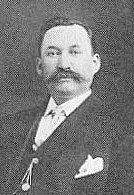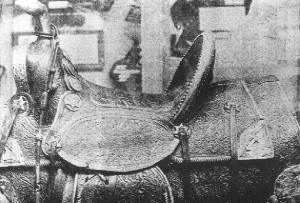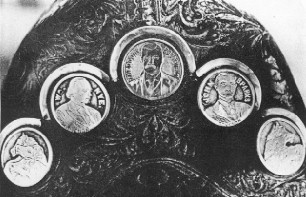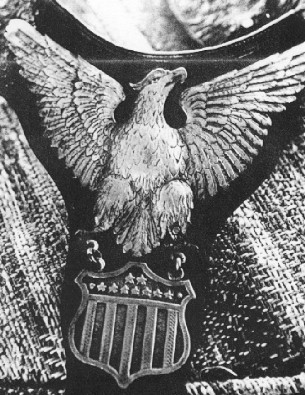World Famous Saddle
Made by G.S. Garcia in Elko - 1903
It was the most beautiful saddle at the 1904
World's Fair at St. Louis, Missouri. Then, at the Lewis and Clark Exposition
in Portland, Oregon, the leather creation won another gold medal. No saddle
had ever received two gold medals and it is a record that has not been
matched. G.S. Garcia of Elko was the maker.
 Guadalupe S. Garcia was born in Sonora, Mexico. When he was three years
old his family moved to San Luis Obispo, California. Fascinated with saddle
making and engraving, he became an apprentice at age 19 to Arana, a master
in the business. Garcia learned quickly and soon opened his own place in
nearby Santa Margarita.
Guadalupe S. Garcia was born in Sonora, Mexico. When he was three years
old his family moved to San Luis Obispo, California. Fascinated with saddle
making and engraving, he became an apprentice at age 19 to Arana, a master
in the business. Garcia learned quickly and soon opened his own place in
nearby Santa Margarita.
As his fame grew in fame, Nevada cowmen began
buying from him. Garcia heard many stories of Elko, a busy cowtown in northeast
Nevada. He and his wife, Saturnina, arrived in Elko the day before Thanksgiving
in 1896 with two suitcases of spurs, bits, reatas, headstalls, and reins.
Within a week he rented a building on Railroad Street and nailed up a sign
proclaiming he was a harness and saddle maker.
For 36 years he and his family and superb
craftsmen turned out quality gear for buyers all over the world. Included
were several Nevada governors, humorist Will Rogers, and actor Douglas
Fairbanks. Ordinary cowboys thought nothing of shelling out a full season's
pay to own one of Garcia's leather seats.

He decided to craft a saddle to take to the World's Fair. He and his workers
assembled the finest saddle every made. Using flawless leather, they dyed
it black, carved in American Beauty roses, and then adorned it with gold,
silver, and diamonds. It was truly a leather throne.

Across the
rear of the fork were several $20 gold pieces with likenesses of President Theodore Roosevelt and
two governors of Nevada, John Sparks and William Nye. Other gold pieces were carved with the famous
three fairy horses with diamonds set in their eyes. An engraved eagle was set into
the back of the cantle. It was a leather masterpiece and it lived up to
its creator's expectation by winning two gold medals. It was the best in
world.
G.S. didn't rest on his success. In 1913 he
founded the Elko Rodeo which featured some of the roughest and meanest
bucking stock in the West. He bought a ranch in Diamond Valley near Eureka
but still personally supervised the work in his Elko shop and, more often
than not, he did cutting and engraving himself. His product were all proudly
stamped with his name and, today, are collector's items. Even his catalogs
are found in many private and public collections and museums.
In 1932, at age 68, he turned over the shop
to his sons and moved to Salinas, California, hoping the change of climate
would help his ailing health. A year later, on April 28, 1933, he died
of a kidney ailment. Saturnina lived until February, 1957.
His sons kept the Elko business going for
six more years, then moved it to Salinas and continued quality craftsmanship
until World War II shortages forced them to close.
Garcia was survived by daughters Laura and
Adelina, and sons Leslie, Henry, and Edward. Another son, Walter, died
in Elko of an ulcer disease in 1929. Henry continued saddle making for
a time in and Les ran a silver import and engraving business in Reno. The
rodeo grounds and Garcia home site are now a mobile home area on Elko's
south side.
The name G.S. Garcia continues to be respected.
Many area people still own one of his saddles, bits, spurs or bridles crafted
by the famed saddle maker who called Elko home.
His famous saddle is on exhibit at the Nevada
State Museum in Carson City.
Howard Hickson
February 23, 2001
Sources: G.S. Garcia, Elko, Nevada, A History of the
World Famous SaddleMaker, by David L. Van Meter, 1948; "J.M. Capriola
Company" by Bill Nelson, Northeastern Nevada Historical Society Quarterly,
(83-3) Summer, 1983; and an article, "G.S. Garcia," I wrote in 1978 for
the Elko Independent.
All photographs are from the Northeastern Nevada Museum,
Elko, collections.
©Copyright 2001 by Howard Hickson. Anyone
is welcome to quote or use any portion or all of this article but proper
credit must be given to the author.
[Back to Hickson's Histories Index]
 Guadalupe S. Garcia was born in Sonora, Mexico. When he was three years
old his family moved to San Luis Obispo, California. Fascinated with saddle
making and engraving, he became an apprentice at age 19 to Arana, a master
in the business. Garcia learned quickly and soon opened his own place in
nearby Santa Margarita.
Guadalupe S. Garcia was born in Sonora, Mexico. When he was three years
old his family moved to San Luis Obispo, California. Fascinated with saddle
making and engraving, he became an apprentice at age 19 to Arana, a master
in the business. Garcia learned quickly and soon opened his own place in
nearby Santa Margarita.


